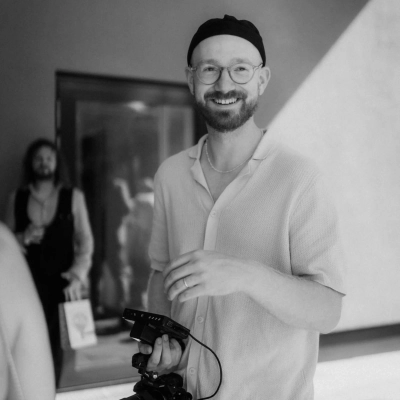18 Tips for Creating Engaging Video Content
Creating engaging video content requires strategic planning and execution, as demonstrated by the collective wisdom of content marketing professionals. This article presents 18 practical tips covering everything from crafting attention-grabbing hooks to prioritizing audio quality and authentic storytelling. Drawing from expert insights, these strategies will help transform ordinary video content into compelling narratives that connect with viewers and drive meaningful engagement.
Create Powerful Hooks That Interrupt the Scroll
My best tip for producing engaging video content is to always hold a banana in your hands. People will not be able to resist watching. It's a proven tactic for getting attention.
Did you see what I did there? That's called a hook. A hook is the first line of text or the first few seconds of a video. And it's designed to interrupt the scroller and get them to keep reading (or watching).
The hook is the most important part of any video. Because if you start without anything else, your views are going to suffer.
There are 2 main types of hooks:
1) Word hooks — what you say in the opening line. Example: I once asked, "Are you team b-roll or no b-roll?" It blew up to 100,000+ views on LinkedIn because entrepreneurs have strong opinions about it, and those who didn't learned what b-roll is and why it matters.
2) Movement hooks — what you do visually in the first seconds. This could be holding up a prop, zooming the camera, or even just leaning in with a knowing look. Movement hooks stop the scroll before you've said a word.
When you combine the two, that's when videos really pop.

Showcase Real Customers in Authentic Environments
The most effective video content showcases real customers using your products in authentic environments, which creates relatability and trust with your audience. We developed specific customer personas and then created videos featuring actual customers using our products in natural settings with their families and colleagues, which resonated strongly with our target market. Additionally, implementing a two-way engagement strategy where we actively responded to comments on our social media videos helped build community around our content. This approach significantly increased our repeat customer orders as viewers could see themselves in our content and felt heard when they engaged with our brand.

Script Around Rhythm to Maintain Emotional Engagement
The best tip I give is to script around rhythm, not just content. Attention thrives on pacing that alternates intensity and relief. Flat delivery loses viewers even when information is strong. By controlling rhythm, we maintain emotional engagement alongside intellectual clarity. Rhythm transforms communication into entertainment without diluting meaning.
We used this approach in a client's product launch video. Complex information alternated with humor and light personal anecdotes. The variation kept audiences engaged while still delivering serious insights. Shares skyrocketed because people enjoyed the balance. Rhythm was the silent driver of success.
Make Content Shareable Through Clarity and Value
One of the best tips for creating engaging video content is to make it shareable. We learned this through a video we created about our partnerships. The footage was concise, informative and easy to understand which made it highly shareable. Viewers found value in the content and its clear format made them want to share it with others. The video presented the key information in a straightforward way avoiding any unnecessary complexity.
Additionally we focused on creating content that informs and engages viewers. When people feel that a video adds value to their understanding or brings something useful to their network they are more likely to share it. By focusing on value and clarity we increased the video's reach. Shareable videos often result in wider exposure and help to build stronger connections with viewers.
Involve Your Audience Through Interactive Elements
My top recommendation for creating engaging video content is to directly involve your audience in the creative process through interactive elements. We've seen great success with videos that ask viewers specific questions or invite them to vote on design options, which significantly increases comment rates and overall engagement. One particularly successful approach has been creating follow-up content based on audience questions, which not only rewards viewer participation but also ensures our message resonates with what our audience actually wants to know. This strategy creates a feedback loop that builds community while simultaneously improving our content quality and message effectiveness.

Tell Authentic Stories Viewers Recognize or Aspire To
The best video content is not intended to yell at people to get them to listen but instead introduce them to a story they care about. At Legacy Online School, we have found that parents and students don't relate to a polished sales pitch. Instead, they identify with seeing themselves in the story.
One of our best performing videos was not the one with the best editing. It was a kid's simple day in the life after having moved to Legacy from traditional schooling. We show her waking up and starting her day after breakfast, the pacing was truly at her speed. She moved into a math lesson, took a break midday to practice violin, and then she joined her virtual club with friends from across the world. The production value was low, but the authenticity was incredible.
The three keys were simple: first, allow the student's real voice, and don't script every word. Second, find emotional beats - relief, joy, thrill, wonder, etc. Third, have a pacing that respects the limited attention spans but lasts long enough to get the message to land.
That video doubled our engagement compared to more polished campaigns because it felt human and relatable. The lesson I took from that is simple: people don't want to watch an ad, they want to watch a life they recognize or aspire to. If you can capture that honestly, the message carries itself.

Follow the Three-Act Storyline Flow Framework
We follow the "STORYLINE FLOW FRAMEWORK," which is based on the traditional three-act structure -- setup, challenge, resolution -- because that's how stories are plugged into our brains. This keeps our audience interested and makes the message seem like it's flowing naturally and easily. We maintain consistent tone, pacing and imagery so that when viewers see the style they immediately know what it is and focus on the message rather than the delivery. This approach absolutely establishes trust and ensures each video has a clear function and feels connected.
We've recently used this structure recently for a client's video to launch product. The narrative began with a common pain point, created tension around the issue and closed out focusing on their product as the solution. This narrative helped the viewers connect with the story on an emotional level and resulted in an overall 32% improvement in landing page conversions, a testament to how effective a well-crafted story can be.

Prioritize Audio Quality as Much as Visuals
My advice is to invest in high-quality audio as much as visuals. Audiences forgive shaky visuals but rarely tolerate poor sound. Clear, crisp audio enhances comprehension and trust. When voices resonate well, content feels more authoritative. Sound quality is an underrated driver of engagement.
We discovered this with a webinar turned into evergreen video content. The first iteration had distracting audio, limiting viewer retention. After investing in microphones and mastering, retention improved dramatically. Viewers commented specifically on clarity. Audio quality directly determined communication success.

Start With an Emotional Hook and Clear Intention
One of the most important lessons I've learned when creating video content that captures people's attention is to ensure clarity and pacing from the beginning. Viewers make their decision to stick around in a few short seconds, so starting off with either an impactful visual hook or emotional appeal is crucial. I also make sure that there is intention to every frame, whether it's supporting the story, showcasing product detail, or leading the viewer's eye. For our brand, where emotions are fundamental to the decision-making process, I've found that careful music selection and strategically timed text overlay ensure messages are both clear and emotive in case someone is watching without sound. Keeping videos short, since many of them run under two minutes in most formats, has also been helpful in holding the audiences' attention while keeping them from being overwhelmed.
One of our successful videos we created was a basic yet emotional story about how families memorialize loved ones with urns within everyday spaces. The story game in the campaign was much less of a linear path. Instead of simply counting on scripted dialogue or visual cliche, we focused on natural imagery: a daughter placing flowers next to urns placed on a shelf, a quiet portrait within a garden service, and close-ups that accentuate craftsmanship. This mix of storytelling and product information paid off with increased engagement as viewers watched longer and shared the video more often than past campaigns. People connected with it not just because of the production quality, but because it felt real and relatable. That was another example for me that with video content, it's about telling a story that connects emotionally and shows the product in an honest, dignified way.

Create Content You Would Want to Watch
The best tip I can give is to create something you'd actually want to watch yourself. If it doesn't grab your attention, it's not going to grab anyone else's. For us, that often means sharing behind-the-scenes videos from our photoshoots. Those clips feel real and immersive, and they let people peek into the process. It's the kind of content we enjoy watching, so it's no surprise our audience does too.
Most of our video content is also created in collaboration with our clients. That way, we're not only reaching our own audience, who already connects with our work, but also theirs, who loves what they're doing. It's a win-win that doubles the impact.
As an example - here's our most recent collaboration with LoveBirds Donuts in Kittery, ME. This video got us more engagement than almost anything else we've ever posted, and it's because it has a simple message - donuts, donuts, and more donuts.
https://www.instagram.com/reel/DOtuaJgjc9J/

Connect Emotionally Through Relatable Pain Points
To create a perfect video content, one needs a script/story that actually connects emotionally and feels relatable to the visitors. Where message is concise and stay in memory for long time. Those who watch remember the narrative rather than facts. Hence, keeping the content around the pain point draws the attention and combining them with memory enhances the learning effect. Further, lead your audience to action with string CTA. For example, a 60-seconds video should not only list down your app features but also makes a story around it which shows relatable pain points for users and provide solution to them so that there are no delays or missed deadlines. Let users see them in that story, use high quality stunning graphics and animations, and support with clickable links.
The result was 40% hike in demo booking when we created a video that described our user persona effectively. And the combination of content and visuals brought 21% more engagement as well only in 3 months.
Focus on a Single Clear Insight
My best piece of advice is to start by anchoring your video content around a single and clear insight — something that could resolve the confusion or misconception that so many people have and then break it down into a way that feels conversational and understandable. Focus on depth versus breadth (especially if it is a complex topic) rather than trying to cover too much material.
A good example is our "The Best Marketing and Advertising Agencies to Hire in 2025
" video https://www.youtube.com/watch?v=gbfghlgFFXM. In terms of approach to the video style, we kept it simple just voiceover and slides and we let the message be the message. In terms of pacing, we allowed each point to build from the last, with common language to reinforce comprehension rather than marketing terminology.
What made the video successful was not just the content but the structure. We started off with a clear definition, using analogies to support the understanding, and ended with a straightforward call to action. That clarity has allowed this to be one of the most consistently viewed videos by DesignRush users and agency decision-makers

Lead With Story, Let Data Follow
Video isn't just a format; it's a chance to move culture. Our most effective videos start with one rule: lead with story, let the data follow. A good example shared on Ranked's own LinkedIn page is our Ranked/Roku sizzle reel, which showcased how micro and nano creators helped Roku connect with audiences across continents. This example is company-reported and not independently verified.
What made it work?
* Creator-led storytelling: real people, real neighborhoods, no scripted jargon.
* First-party connection: no cookies, just authentic engagement between creators and viewers.
* Micro-influencer focus: the same approach our public site reports delivers 4-7x higher engagement than macro influencers.
When viewers feel they're part of the story, not targets of an ad, you don't have to chase attention. They stay, they share, and your message travels farther than any paid placement could.
Weave Micro Testimonials Throughout Your Narrative
Persuasion happens through what the "eye catches" and the "heart registers," not just statements.
Interleaving MICRO TESTIMONIALS and DATA DROPS, short snackable proof embedded within the narrative, creates continuous credibility without disrupting flow. These credibility cues act like "validation checkpoints," reinforcing the message while keeping momentum intact. Designing spikes, moments of intrigue, visual bursts, or emotional jolts every 10 to 15 seconds resets focus and prevents a natural drop off.
In a conversion video, we inserted five testimonial snippets, each under two seconds, paired with fast-moving data animations to STRESS IMPACT. We layered in sudden color shifts and sharp cuts to sustain energy throughout the runtime.
That video delivered a 40% higher click-through rate compared to anything produced before. What drove the performance was proof woven seamlessly into the message, combined with deliberate attention resets. Beyond engagement, these techniques also improved MESSAGE RECALL in post-campaign surveys and extended average view duration. It showed that credibility elements, when blended with dynamic editing rhythms, can directly translate into measurable business outcomes.

Embrace Raw Authenticity Over Polished Production
I think the best tip for creating video content is to be authentic. I know that sounds like the obvious but then the barrier to entry has been lowered as far as content is concerned so anyone can make video and edit it themselves with tools like Descript and Capcut and whole host of other tools. It's actually pretty easy to do but if you want to get lots of our viewers then authenticity is key.
We have a youtube channel that has gaine 6000 subscribers in the first 3 months and we have guests on to come talk in podcast style talks about all sorts of subjects and one of those videos has 17000 views which is good for an infant channel. It's this one https://www.youtube.com/watch?v=aCKNab3oPfM&t=3s and the beauty of our talks is they are unpolished and raw and that is what we believe the public want. As Google and Meta bring out tools that can generate video quickly in any language even it will all feel a little samey in the near future and so having raw content is more engaging than the polished versions.

Capture Attention in the First Few Seconds
Honestly? The first few seconds matter way more than people think.
I've noticed that everyone gets caught up in storytelling and fancy production, but most viewers decide whether to keep watching within seconds of hitting play. If you don't grab them immediately, the rest doesn't matter.
Here's what I've learned works:
Start with something that makes them stop scrolling. Could be a surprising statement, showing the end result first, or just getting straight to the point instead of a long intro.
Make sure what you're showing matches what you're saying. Sounds obvious, but you'd be amazed how often the visuals fight against the message instead of supporting it.
Know your specific audience. What works for one group completely bombs with another. Generic advice is mostly useless.
We worked with a skincare company that was struggling with their product videos. Their professionally-shot studio content looked great but wasn't converting. We tried something different: had creators film in their actual bathrooms with natural lighting, focusing on close-ups while talking about specific skin problems.
The bathroom videos performed twice as well. Turns out people trusted content that looked like their own mirror experience more than the polished studio stuff. The authenticity mattered more than production value.
The bigger picture here is that assumptions about what "good" video looks like are often wrong. What actually engages people varies wildly depending on who you're trying to reach. Instead of following general best practices, figure out what specifically works for your audience.
Most people are just guessing what will work. The creators who consistently succeed are the ones who pay attention to what actually gets results, not what they think should work.

Ground Your Message in a Relatable Metaphor
My best tip for creating engaging video content is to ground your message in a simple, relatable metaphor and then build the lesson around it. In one of my videos, for example, I compared snow to silence. Snow doesn't just fall, it muffles the world, creating a hush that makes you listen differently. That image immediately pulls the viewer in, and from there I connect it to communication: the power of leaving white space, of using pauses, of letting silence carry meaning.
The key is that people remember stories and images more than abstract advice. By using a metaphor, you create a visual and emotional hook. Then you deliver the insight in a way that feels natural, almost like a discovery the viewer is making with you.
So my advice is: don't just tell people your message...show them through story, metaphor, or lived experience. That's what keeps them watching and, more importantly, remembering. WATCH HERE: https://www.facebook.com/reel/1686742835256391

Shift Focus From Product to Audience Needs
Creating engaging video content requires a shift in focus from your product to your audience. My most successful approach involves three key principles:
First, create an irresistible hook. People aren't naturally interested in your product—they care about themselves.
Start with something viewers instantly identify with, whether it's a celebrity, location, or current trend. Follow with subtle foreshadowing that makes them want to keep watching.
Second, strategically encourage engagement. Ask viewers directly to share or save your content.
These actions carry more weight than likes in most algorithm systems, as platforms prioritize content that keeps users on their sites longer.
Third, be persistent across platforms.
Some of my most successful videos didn't perform initially on YouTube Shorts or Instagram, but later exploded on TikTok after refinement and retesting.
I applied these principles when marketing my wedding photography business. Instead of showcasing my services directly, I created videos featuring luxury wedding venues—exactly what couples research when they're close to making vendor decisions. This strategy helped me reach over 1.3 million accounts in my target demographic (25-34 year-old German women), representing 70% market coverage for my audience on TikTok. One campaign generated 100,000 saves for a service that can only accommodate 40 bookings annually, and I replicated this success 15 times in 26 attempts using the same concept.
The key was meeting potential clients where they were in their journey and demonstrating my skills through content they actually wanted to consume, rather than pushing my services directly.






